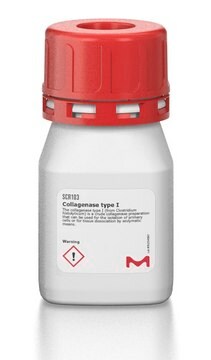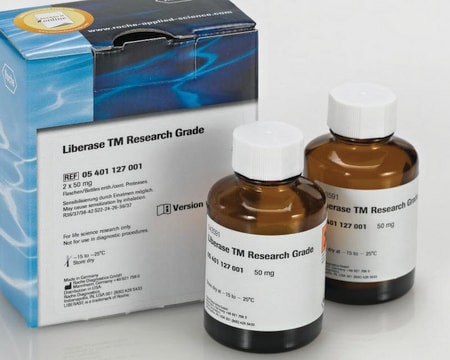General description
Collagenase is a protease which cleaves the triple-helical protein called collagen. There are three types of tissue collagenases, and these belong to the matrix metalloproteinases (MMP) family. Collagenase obtained from Clostridium histolyticum has a very strong activity, as it digests collagen from both ends, at temperatures as low as 4-10°C. Crude collagenase mixtures contain two major enzyme types namely, collagenase and clostripain.
Application
Collagenase from Clostridium histolyticum has extensive use in biological studies, where it is used to prepare isolated cell suspensions. This product is suitable for the disaggregation of human tumor, mouse kidney, human adult and fetal brain, lung and many other epithelia tissues. It has also been shown to be effective in liver and kidney perfusion studies, digestion of pancreas, isolation of nonparenchymal rat liver cells and hepatocyte preparation. Collagenase has also been used in the preparation of arterial tissue for the study of Advanced Glycosylation End Products. This enzyme has been tested for the release of heptatocytes at a concentration of approximately 1 mg/mL. Concentrations for digestion range from 0.1 to 5 mg/mL.
Biochem/physiol Actions
The collagenase product is a mixture of enzymes secreted by C. histolyticum, with different products differentiated by the relative ratios of the 10-18 components found in the secreted enzymes. The main components are two collagenases, clostripain, and a neutral protease. The synergistic action of these enzymes degrade collagen and other intracellular materialThe action of both collagenase enzymes and the neutral protease is necessary for effective release of cells from tissue. Various types of collagen are the natural substrates for collagenase.
Collagenase is activated by four gram atom calcium per mole enzyme. It is inhibited by ethylene glycol-bis(beta-aminoethyl ether) - N, N, N′,N′-tetraacetic acid, beta-mercaptoethanol, glutathione, thioglycolic acid and 8-hydroxyquinoline.
Caution
As supplied, this product is stable for one year at -20°C. There is no loss in FALGPA or protease activity in 30 days at 37°C, 50°C and -20°C. Solutions of crude collagenase are stable if frozen quickly in aliquots (at 10 mg/mL) and kept frozen at -20°C. Further freeze-thaw cycles will damage the solution. The product retains 100% activity over 7 hours when held on ice.
Unit Definition
One collagen digestion unit (CDU) liberates peptides from collagen from bovine achilles tendon equivalent in ninhydrin color to 1.0 μmole of leucine in 5 hours at pH 7.4 at 37 °C in the presence of calcium ions. One FALGPA hydrolysis unit hydrolyzes 1.0 μmole of furylacryloyl-Leu-Gly-Pro-Ala per min at 25°C. One Neutral Protease unit hydrolyzes casein to produce color equivalent to 1.0 μmole of tyrosine per 5 hr at pH 7.5 at 37°C. One Clostripain Unit hydrolyzes 1.0 μmole of BAEE per min at pH 7.6 at 25°C in the presence of DTT.
Preparation Note
This product is an equivalent to first 40% ammonium sulfate fraction of Mandl, I., et al., J. Clin. Invest., 32, 1323 (1953). Solutions are typically prepared at 1-2 mg/mL in TESCA buffer (containing 50 mM TES, 0.36 mM Calcium chloride, pH 7.4 at 37°C.










